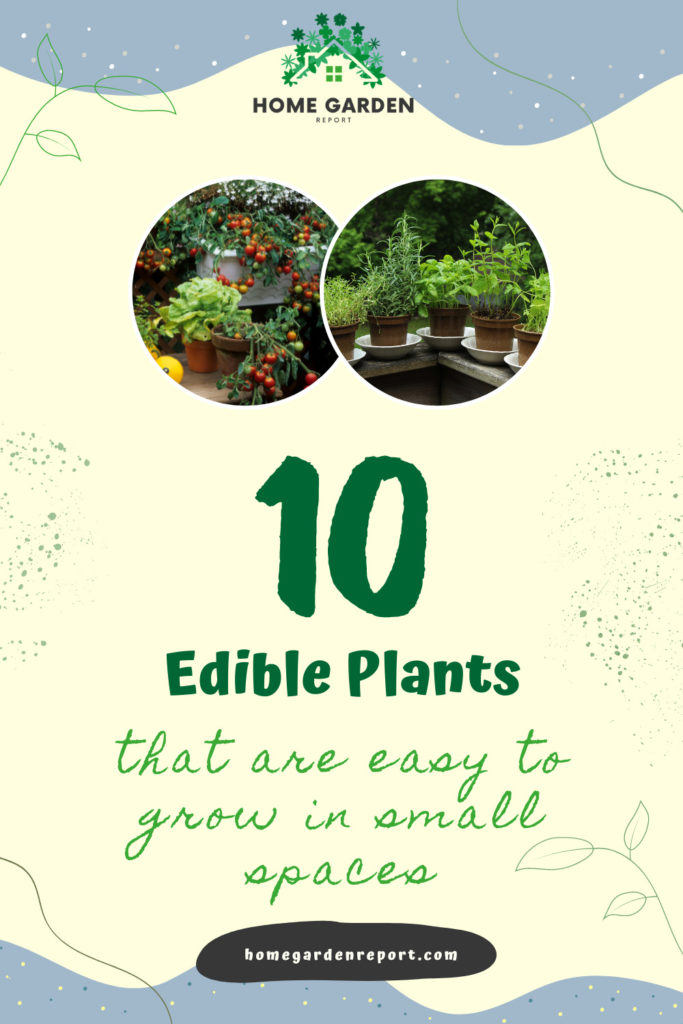
In the heart of every concrete jungle, a green revolution is sprouting. Amid the high-rises and hustle, more and more urban dwellers are rolling up their sleeves, digging into the soil, and discovering the pure joy of home gardening. Yet, one might wonder, how can you cultivate a lush, verdant garden in a small apartment balcony or a cramped city flat? The answer is as simple as it is surprising: all you need is a little know-how and a choice selection of the right plants.
Welcome to our comprehensive guide: “10 Edible Plants That Are Easy to Grow in Small Spaces”. This post is your go-to source for transforming even the tiniest corner of your home into a thriving, edible oasis. We’re not just talking about a pot of basil on your windowsill – though we do love fresh basil. We’re talking about cultivating a range of plants that are nutritious, delicious, and flourish in small spaces.
You might be new to the world of green thumbs and compost, or perhaps you’re an experienced gardener looking to scale down. Regardless of your starting point, this guide is designed to help you sow the seeds of success in your compact home garden. Over the next sections, we’ll delve into the myriad benefits of homegrown produce, consider important factors for small-space gardening, and finally, explore our top 10 edible plants perfect for your indoor or outdoor small space.
So, let’s plunge our hands into the soil and embark on this rewarding journey towards sustainable, healthy living. After all, the best salads are those where you can say, “I grew this myself!”
Why Grow Your Own Edible Plants?
What if we told you that growing your own edible plants could offer you so much more than just fresh, delicious produce? Indeed, nurturing your little patch of green can not only grace your table with farm-fresh ingredients but also serve as a stepping stone towards a healthier lifestyle, a more sustainable world, and even a thicker wallet. Intrigued? Let’s explore these benefits in more detail.
Health Benefits: Fresh and Pesticide-Free Produce
When you grow your own fruits, veggies, and herbs, you have control over your food supply. You know exactly what goes into your plants, and what doesn’t. That means saying goodbye to harmful pesticides and genetically modified organisms (GMOs). Additionally, you’ll be able to harvest your crops at their peak, ensuring maximum nutritional value and taste. Remember, nothing can quite match the flavor of a tomato still warm from the sun, or the aroma of freshly plucked basil.
Environmental Benefits: Reducing Your Carbon Footprint
Your mini home garden could contribute to big environmental change. By growing your own food, you help reduce the demand for commercially farmed produce, which often involves resource-intensive practices and contributes to carbon emissions due to transportation and packaging. Plus, plants act as natural air purifiers, reducing carbon dioxide and releasing oxygen into your home. That’s a breath of fresh air in more ways than one!
Economic Benefits: Save Money on Groceries
Growing your own food can also ease the pressure on your wallet. Seeds, seedlings, and even young plants are usually significantly cheaper than their full-grown counterparts in the supermarket. Plus, with the right care, they can yield an abundance of produce over a long period. That’s a return on investment that Wall Street would be envious of!
Personal Satisfaction: Nurturing a Life from Seed to Harvest
There’s something incredibly rewarding about watching a tiny seed sprout into a thriving plant that ultimately bears fruits or vegetables. It’s a tangible, delicious manifestation of your efforts, and one that brings with it a unique sense of accomplishment. It can also be a fantastic educational tool for children, teaching them about life cycles, responsibility, and the value of nature.

In the next section, we’ll guide you through the key considerations when growing plants in small spaces, laying the foundation for your successful home garden. So, let’s grab our trowels and dig deeper into the green world of edible plants.
The Top 10 Edible Plants for Small Spaces
When you’re ready to begin your urban gardening adventure, the sheer variety of edible plants can feel overwhelming. But fear not, we’re here to guide you through the verdant jungle of options. In this section, we’ll explore the top 10 edible plants that are perfectly suited to thrive in small spaces, whether it’s your sunny windowsill or balcony planter. For each, we’ll discuss their nutritional benefits, planting and care tips, and harvesting know-how.
1. Herbs (Basil, Mint, Parsley, etc.)

Description and Nutritional Benefits: Herbs are the aromatic champions of small space gardens. Basil, mint, parsley, rosemary, thyme – the list is long and flavorsome. Not only are they culinary superstars, but they’re also rich in vitamins and antioxidants.
Planting and Care: Most herbs love sunlight and well-draining soil. Plant seeds or starter plants in pots, ensuring they have enough space to grow. Regular harvesting encourages new growth.
Harvesting Tips: Harvest in the morning for the best flavor, cutting off at the stem. Never harvest more than one-third of the plant at a time.
2. Lettuce

Description and Nutritional Benefits: Lettuce, particularly loose-leaf varieties, are perfect for small space gardening. They’re packed with vitamins A and K, and since you can pick as you go, they’re a gift that keeps on giving.
Planting and Care: Sow lettuce seeds directly into containers or hanging baskets. They prefer cool weather and a bit of shade in hotter climates.
Harvesting Tips: Harvest outer leaves when needed, allowing the plant to continue producing new leaves in the center.
3. Peppers
Image: A vibrant pepper plant in a pot.
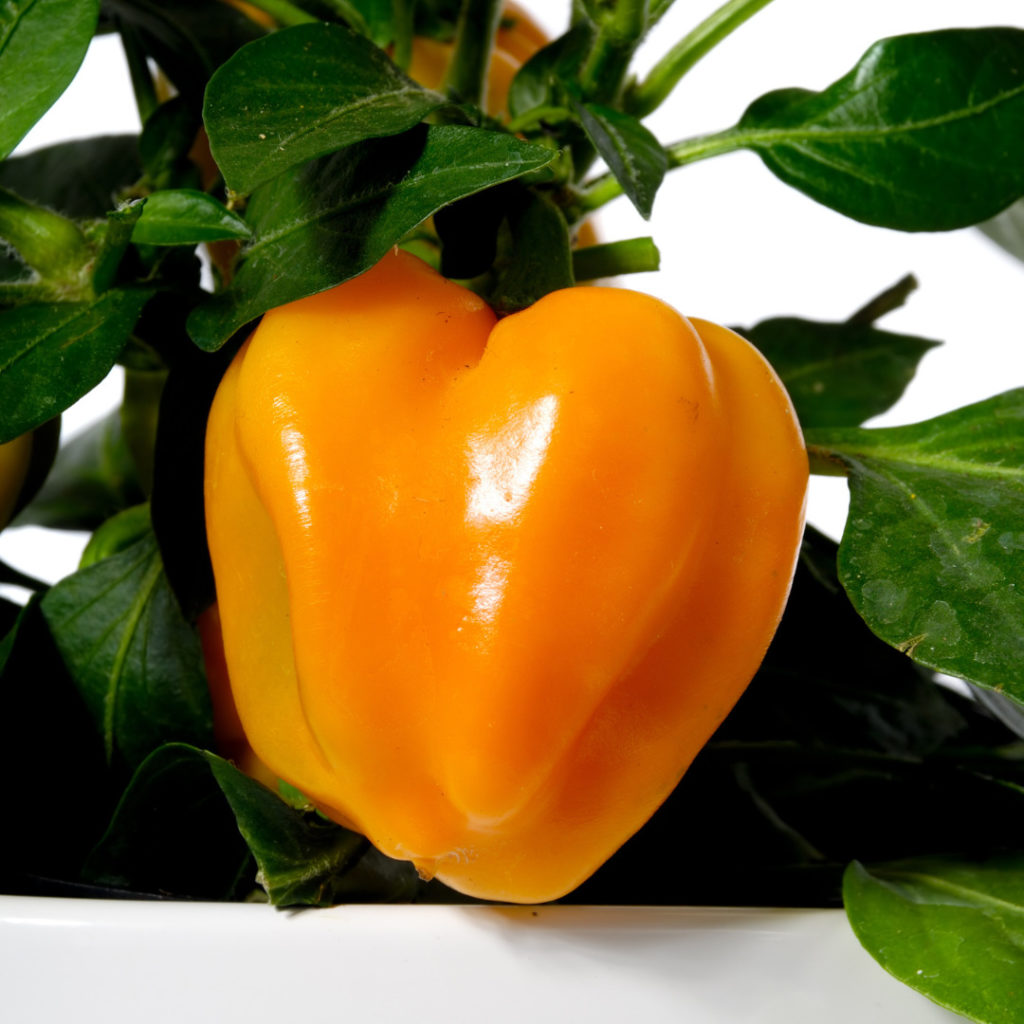
Description and Nutritional Benefits: From bell peppers to spicy jalapenos, these plants are compact and highly productive. They’re packed with Vitamin C and add a flavor punch to any dish.
Planting and Care: Plant in a well-draining pot with plenty of sunlight. Water regularly but do not overwater.
Harvesting Tips: Peppers can be harvested when they reach their desired size. The more you harvest, the more they’ll produce!
4. Tomatoes

Description and Nutritional Benefits: Nothing beats the taste of homegrown tomatoes! They’re a great source of vitamins A and C and can be used in a wide variety of dishes.
Planting and Care: Tomatoes need a sunny spot and a big container. They require consistent watering and benefit from support structures like cages or stakes.
Harvesting Tips: Pick tomatoes when they are fully colored and slightly soft to the touch.
5. Radishes

Description and Nutritional Benefits: Radishes are a crunchy, spicy addition to salads and are rich in vitamins A and C. Plus, they grow quickly, offering almost instant gratification.
Planting and Care: Sow radish seeds directly into pots, and keep the soil evenly moist. Radishes grow fast and can be harvested in just a few weeks.
Harvesting Tips: Harvest radishes as soon as they mature (typically 3-4 weeks after planting) to prevent them from becoming woody.
6. Spinach

Description and Nutritional Benefits: This leafy green powerhouse is packed with vitamins A, C, K, and iron. Spinach grows well in containers and prefers cooler weather.
Planting and Care: Sow seeds directly into pots. Regular harvesting promotes new growth.
Harvesting Tips: Pick leaves from the outside to allow the center leaves to continue growing.
7. Carrots

Description and Nutritional Benefits: Carrots are rich in beta-carotene and vitamin A. Opt for short varieties in container gardening.
Planting and Care: Sow carrot seeds directly into a deep container, as they need room to grow downwards. They prefer cooler weather and consistent watering.
Harvesting Tips: Carrots are ready to harvest when the tops are visible at the soil surface.
8. Beetroot
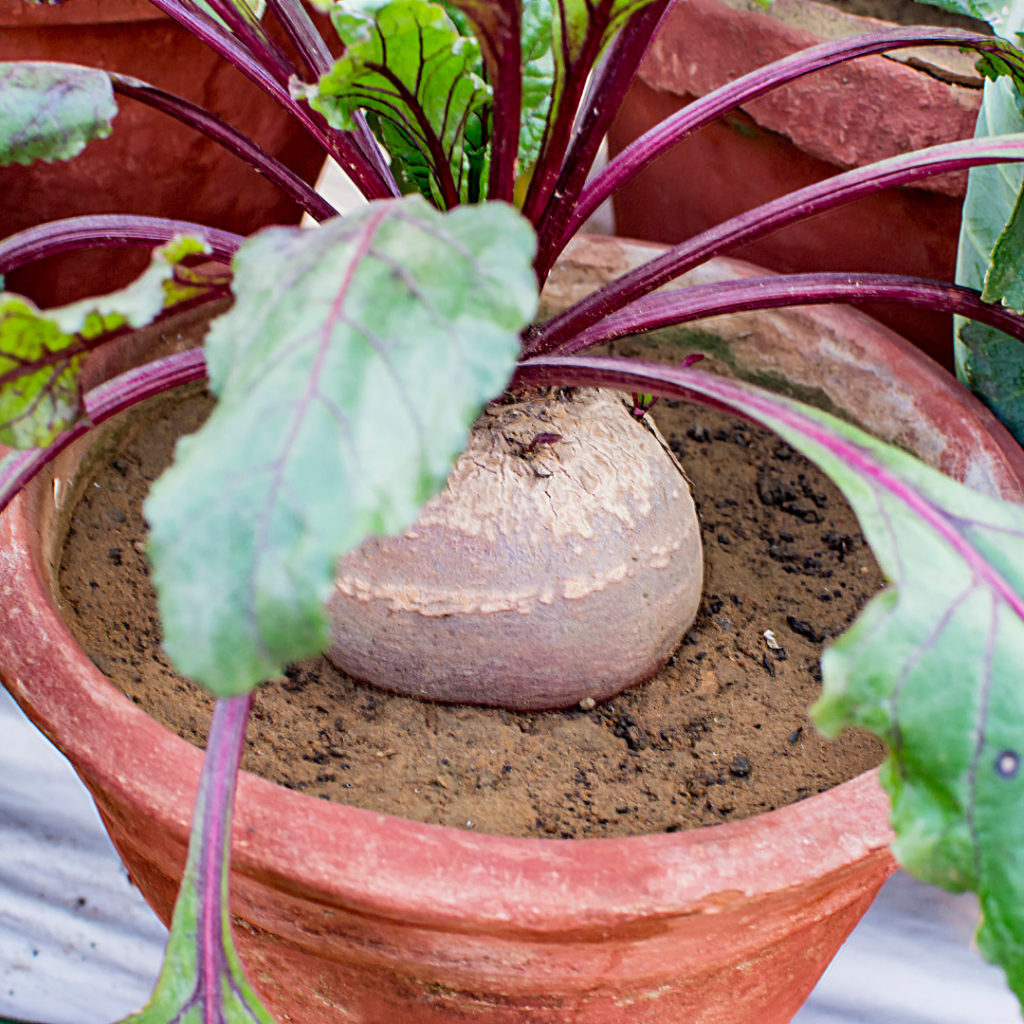
Description and Nutritional Benefits: Beetroots are highly nutritious, packed with fiber, potassium, and vitamin C. They’re great for salads or juices.
Planting and Care: Beetroot seeds should be planted in a deep pot as the root needs space to grow. They enjoy the sun and regular watering.
Harvesting Tips: Harvest beets when they’re about the size of a golf ball for the best taste.
9. Scallions (Green Onions)

Description and Nutritional Benefits: Also known as green onions, scallions are low in calories and high in vitamins A and C. They’re great for adding a mild, oniony flavor to dishes.
Planting and Care: Scallions can grow in small containers and don’t need a lot of sun. You can even regrow them from kitchen scraps!
Harvesting Tips: Harvest scallions when they’re about 6 inches tall. You can cut them at the base, and they’ll regrow.
10. Strawberries

Description and Nutritional Benefits: Strawberries are a sweet treat packed with vitamin C. They’re perfect for small spaces as they grow well in pots and hanging baskets.
Planting and Care: Plant strawberry runners in a sunny spot. They need regular watering but don’t like to sit in water.
Harvesting Tips: Pick strawberries when they are fully red. The more you harvest, the more fruit the plant will produce!
By selecting the right plants and providing a bit of tender loving care, your small space can transform into a productive, edible haven. Up next, we’ll reveal some innovative ways to maximize your gardening space and set you on the path to small-space gardening success!
| Plant | Light Requirement | Water Requirement | Planting Depth | Time to Harvest |
|---|---|---|---|---|
| Cherry Tomatoes | Full Sun | Moderate (consistent moisture) | 1/4 inch | 60-70 days |
| Basil | Full Sun | Moderate (do not let soil dry out) | 1/4 inch | 60-90 days |
| Lettuce | Partial Sun | Moderate (consistent moisture) | 1/4 inch | 30-60 days |
| Mint | Partial Sun to Shade | High (keep soil moist) | Surface (needs light to germinate) | 60-90 days |
| Chives | Full Sun | Moderate (do not let soil dry out) | 1/4 inch | 80-90 days |
| Parsley | Full Sun to Partial Shade | Moderate (consistent moisture) | 1/4 inch | 70-90 days |
| Radishes | Full Sun | Moderate (consistent moisture) | 1/2 inch | 20-30 days |
| Strawberries | Full Sun | High (do not let soil dry out) | Surface (needs light to germinate) | 4-6 weeks after flowering |
| Peppers | Full Sun | Moderate (do not let soil dry out) | 1/4 inch | 60-90 days |
| Spinach | Partial Sun | High (keep soil moist) | 1/2 inch | 40-50 days |
Tips for Maximizing Your Small Space
Just because you have a small space, it doesn’t mean your green ambitions need to be tiny too! Maximizing your space is all about clever use of what you have. So, whether you’re dealing with a petite patio, a compact balcony, or simply a sunny windowsill, these strategies will help you make the most of it.
Vertical Gardening and Hanging Pots:

Think beyond the traditional flat garden plot – why not grow upwards? Vertical gardens are a fantastic way to maximize space. You can hang pots on a wall, use stackable planters, or even repurpose a shoe organizer. Herbs, lettuce, and strawberries are excellent candidates for vertical gardens.
Multipurpose Furniture with Planters:

In tight spaces, dual-purpose furniture can be a game-changer. Consider a table with a built-in planter or a bookshelf that doubles as a plant stand. This allows you to have your plants in the living space without sacrificing utility.
Utilizing Windowsills and Natural Light:

Windowsills, especially those facing south, are prime real estate in a small space garden. They offer plenty of natural light, which plants need to thrive. If your sill is narrow, consider adding a suction-cup shelf to hold more pots.
Using LED Grow Lights:

Not enough natural light in your space? Don’t despair. LED grow lights are energy-efficient and provide the full spectrum of light that plants need. They can be used to supplement natural light or as the primary light source for your indoor garden.
Choose the Right Container Sizes:

Different plants have different root space needs. Tomatoes and carrots need deep pots, while lettuce and herbs can do with shallow ones. By choosing the right container sizes, you can ensure that every inch of soil is effectively used.
Use Climbing Plants and Trellises:

Some plants love to climb. Peas, beans, and cucumbers can be trained to grow up a trellis, freeing up valuable floor space. Trellises can also be used to create a green privacy screen on a balcony.
By implementing these strategies, you can transform even the smallest of spaces into a green, flourishing garden that yields a bounty of fresh produce. In the next section, we will arm you with knowledge about common pests and diseases and how to deal with them, ensuring your garden stays healthy and productive.
Remember, every small space holds the potential for big green possibilities!
Dealing With Common Pests and Diseases
Even the most careful and attentive gardener can encounter pests and diseases. However, don’t let this discourage you. Understanding the common threats and knowing how to manage them can keep your garden healthy and productive. Let’s delve into some common issues and their remedies.
Aphids:
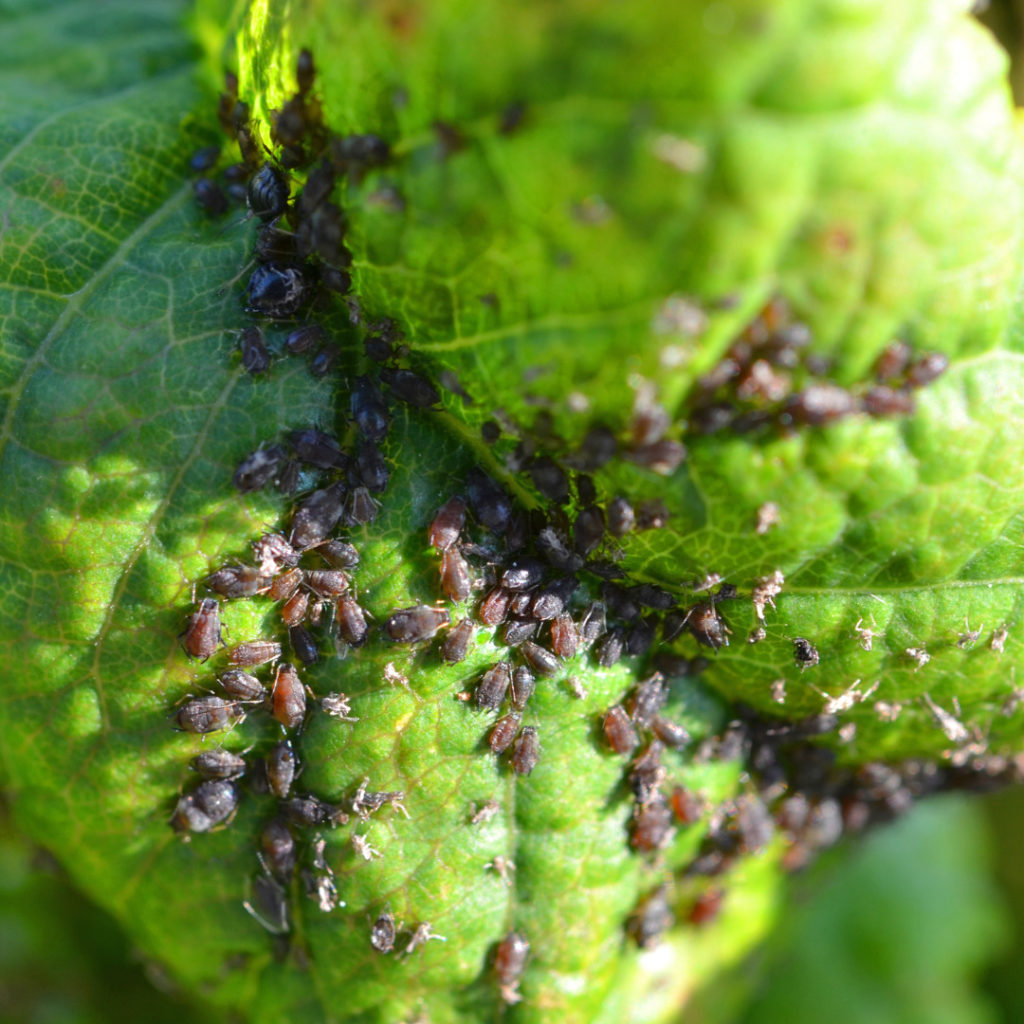
These small, pear-shaped insects are a common sight in gardens. They suck sap from plants, causing curled, yellowed, or distorted leaves.
Solution: Regularly check your plants for aphids. If you notice them, try spraying the plants with a mix of water and mild soap. For more severe infestations, consider using a natural insecticide like neem oil.
Powdery Mildew:

This common fungus appears as white, powdery spots on leaves and stems. It can cause leaves to yellow and curl up.
Solution: Ensure your plants have adequate ventilation and aren’t overcrowded. Fungus prefers moist conditions, so water your plants at the base rather than from above. If your plants become infected, use a natural fungicide.
Blight:

This fungal disease affects many plants but is especially deadly to tomatoes. It causes browning and wilting of leaves, stems, and fruit.
Solution: Rotate crops each year if possible, to prevent the disease from overwintering. Remove infected plants immediately to prevent it from spreading. For preventative measures, consider using a copper-based fungicide.
Slugs and Snails:

These critters enjoy feasting on tender plant leaves, leaving irregular holes behind.
Solution: Remove any hiding places, like leaf piles, near your garden. Encourage natural predators, like birds or ground beetles. You can also use slug pellets or traps filled with beer to attract and kill them.
Caterpillars:
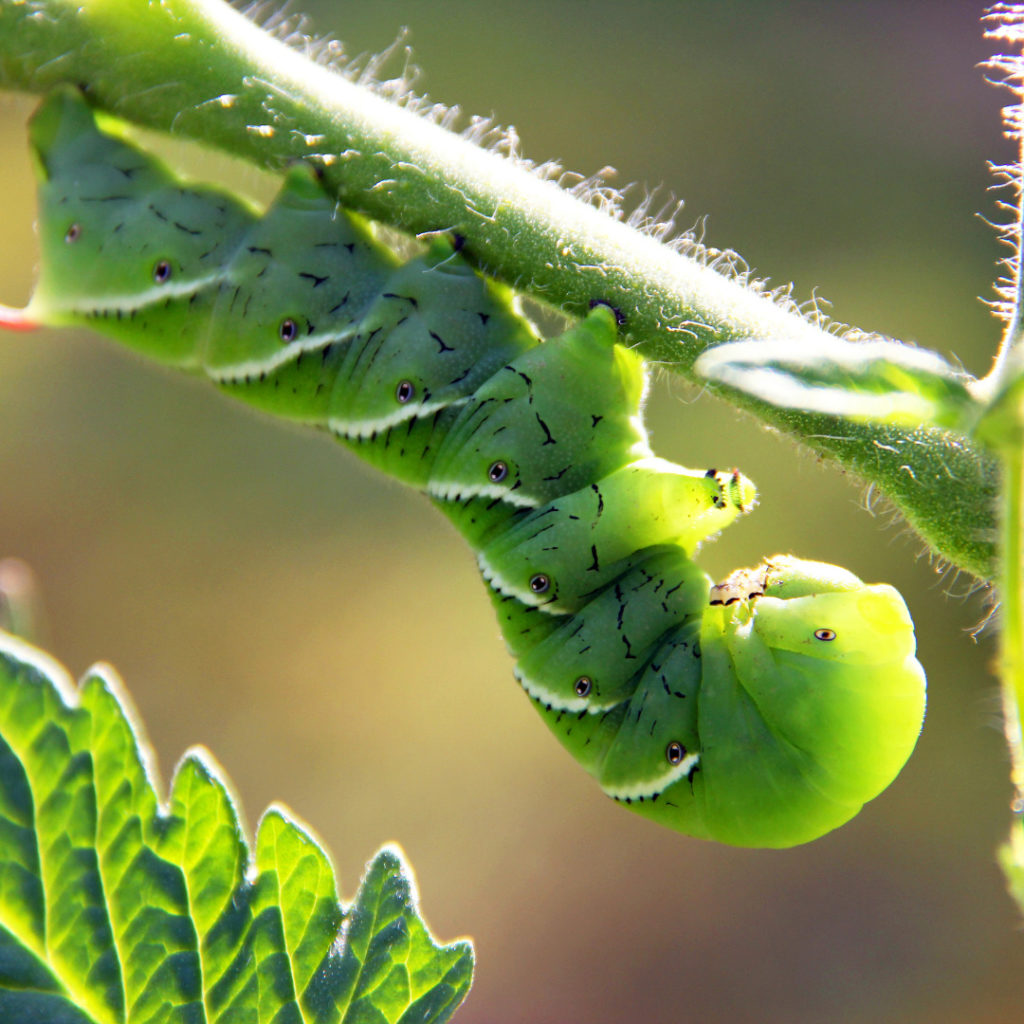
These are the larvae of butterflies and moths. While butterflies can be beneficial pollinators, their offspring can cause significant damage by eating leaves and fruits.
Solution: Handpick caterpillars off plants whenever you spot them. Encourage beneficial insects, like wasps, which are natural predators. For severe infestations, consider using a biological pesticide like Bacillus thuringiensis (Bt).
Remember, with patience, vigilance, and the right strategies, you can keep your garden healthy and thriving, even in the face of pests and diseases.
| Pest/Disease | Symptoms | Plants Affected | Prevention/Treatment |
|---|---|---|---|
| Aphids | Yellow, curled leaves; sticky residue | Most plants | Use insecticidal soap or introduce beneficial insects like ladybugs |
| Slugs/Snails | Irregular holes in leaves and fruit | Leafy greens, tomatoes, strawberries | Use beer traps or diatomaceous earth |
| Whiteflies | White cloud when plant is disturbed; wilting | Tomatoes, peppers, lettuce | Use yellow sticky traps or insecticidal soap |
| Flea Beetles | Small round holes in leaves | Leafy greens, radishes | Use floating row covers or diatomaceous earth |
| Powdery Mildew | White, powdery spots on leaves | Tomatoes, peppers, strawberries, radishes | Ensure good air circulation; use fungicide |
| Blight (Early/Late) | Brown, wilting leaves; rotting fruit | Tomatoes, peppers | Rotate crops; use copper-based fungicides |
| Leaf Spot | Brown or black spots on leaves | Leafy greens, strawberries | Remove affected leaves; use fungicide |
| Root Rot | Yellow, wilting leaves; decayed roots | Most plants | Ensure good drainage; do not overwater |
| Cabbage Worms | Holes in leaves; caterpillars present | Leafy greens | Handpick caterpillars; use Bacillus thuringiensis |
| Spider Mites | Yellow, speckled leaves; webbing | Most plants | Use insecticidal soap; introduce beneficial insects |
Note: The prevention/treatment strategies listed are generally organic in nature. However, always follow local regulations and label instructions when using any pesticide or fungicide.
In the next section, we’ll turn our attention to celebrating your gardening achievements. We’ve got some delicious, easy-to-make recipes featuring your homegrown produce. The fruits of your labor have never tasted so good!
Recipes and Ideas for Your Homegrown Produce
You’ve cultivated your plants, battled pests, and now it’s time for the grand reward – harvest! But what to do with your homegrown bounty? From the simplest of salads to more adventurous culinary creations, we’ve got you covered. Here are some delicious recipes and ideas to make the most of your garden’s produce.
Fresh Herb Pesto

With your herb garden flourishing, making a homemade pesto is a delightful way to savor the fresh flavors.
Ingredients:
- 2 cups of fresh herbs (basil, parsley, mint or a mix)
- 1/3 cup of pine nuts or walnuts
- 1/2 cup of grated Parmesan cheese
- 2 cloves of garlic
- 1/2 cup of extra virgin olive oil
- Salt and pepper to taste
Instructions:
- Combine the herbs, nuts, cheese, and garlic in a food processor and pulse until coarsely chopped.
- While the processor is running, slowly add the oil until well combined.
- Season with salt and pepper to taste.
Serve your fresh herb pesto on pasta, as a sandwich spread, or as a flavorful addition to grilled vegetables.
Strawberry Spinach Salad

This colorful salad is a perfect showcase for your homegrown strawberries and spinach. It’s fresh, healthy, and full of flavor.
Ingredients:
- 2 cups of fresh spinach leaves
- 1 cup of sliced fresh strawberries
- 1/2 cup of crumbled goat cheese
- 1/4 cup of slivered almonds
For the dressing:
- 1/4 cup of olive oil
- 2 tablespoons of balsamic vinegar
- 1 tablespoon of honey
- Salt and pepper to taste
Instructions:
- In a large bowl, combine the spinach, strawberries, goat cheese, and almonds.
- In a small bowl, whisk together the oil, vinegar, honey, salt, and pepper.
- Drizzle the dressing over the salad, toss well, and serve.
Classic Bruschetta

There’s nothing like the taste of freshly picked tomatoes. This classic bruschetta is a simple and delicious way to enjoy them.
Ingredients:
- 4 ripe tomatoes
- 2 cloves of garlic, minced
- A handful of fresh basil leaves, chopped
- 2 tablespoons of extra virgin olive oil
- Salt and pepper to taste
- 1 baguette, sliced and toasted
Instructions:
- Dice the tomatoes and combine them with the garlic, chopped basil, and olive oil in a bowl.
- Season with salt and pepper, then let the mixture sit for 10-15 minutes to allow the flavors to meld together.
- Spoon the tomato mixture onto the toasted baguette slices and serve.
Some Quick and Easy Recipes Using Homegrown Produce:
| Plant | Recipe Name | Basic Ingredients | Preparation Time |
|---|---|---|---|
| Cherry Tomatoes | Fresh Tomato Bruschetta | Cherry tomatoes, fresh basil, garlic, olive oil, baguette | 20 mins |
| Basil | Classic Pesto | Fresh basil, garlic, pine nuts, Parmesan cheese, olive oil | 15 mins |
| Lettuce | Simple Garden Salad | Lettuce, cherry tomatoes, cucumber, your choice of dressing | 10 mins |
| Mint | Mint Tea | Fresh mint leaves, hot water, honey (optional) | 5 mins |
| Chives | Chive and Sour Cream Dip | Fresh chives, sour cream, garlic, salt, pepper | 10 mins |
| Parsley | Parsley Pesto Pasta | Fresh parsley, garlic, almonds, Parmesan cheese, olive oil, pasta | 20 mins |
| Radishes | Radish and Butter Sandwich | Radishes, butter, bread, salt | 10 mins |
| Strawberries | Strawberry Spinach Salad | Spinach, strawberries, feta cheese, balsamic vinaigrette | 15 mins |
| Peppers | Stuffed Bell Peppers | Bell peppers, ground meat or tofu, rice, onion, tomato sauce | 1 hr |
| Spinach | Spinach and Garlic Sauté | Fresh spinach, garlic, olive oil, salt, pepper | 10 mins |
Remember, the beauty of cooking with your homegrown produce is in the freshness of the ingredients. These simple recipes highlight the natural, delicious flavors of what you’ve grown. In our next section, we’ll wrap up and look ahead to more gardening adventures!
Conclusion

Embarking on the journey of growing your own food, even in a small space, is both exciting and rewarding. As we have seen, you don’t need sprawling acres to cultivate an edible garden. With careful selection of plants, efficient use of space, and diligent care, even the smallest balcony or windowsill can become a bountiful garden.
You’ve now got the know-how to get started, from choosing the right plants, maximizing your space, dealing with common pests, to finally enjoying your homegrown produce in simple, delicious recipes.
Growing your own food is not just about the end product. It’s about connecting with nature, understanding the cycle of growth, and taking pleasure in the knowledge that the food you eat is the fruit of your own labor. The taste of a strawberry plucked straight from your garden, or the scent of freshly picked basil, is a joy that’s hard to match.

And remember, gardening is a journey of learning and discovery. Each season will bring its lessons, challenges, and triumphs. Embrace them all, and don’t be afraid to experiment and try new things.
As your gardening confidence grows, so too will your ambition. Perhaps next season, you’ll experiment with new plant varieties, dabble in composting, or try your hand at vertical vegetable gardening. The possibilities are as endless as they are exciting.
In closing, we hope this guide serves as a valuable resource on your gardening journey. Whether you’re just starting or an experienced green thumb, remember, every garden—no matter how small—is a step towards a greener, healthier, and tastier lifestyle.

Thank you for joining us in this gardening adventure, and we look forward to growing with you. Here’s to your blooming and delicious garden-to-table journey!


